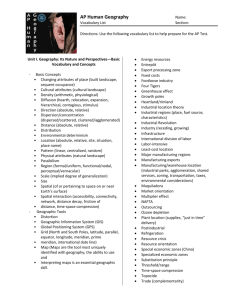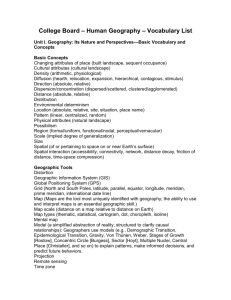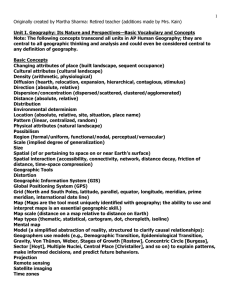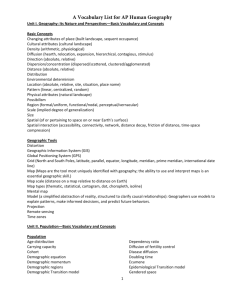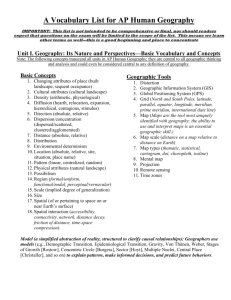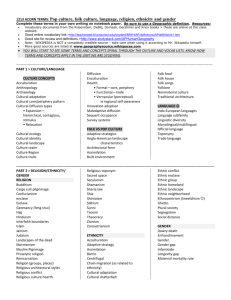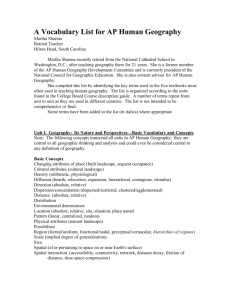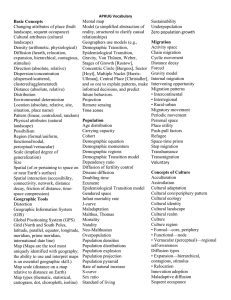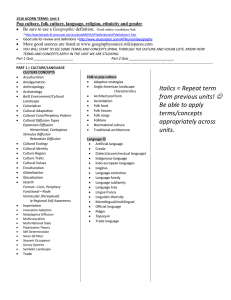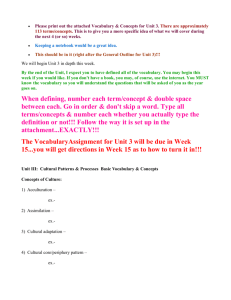Unit 7: Cities and Urban Land Use
advertisement
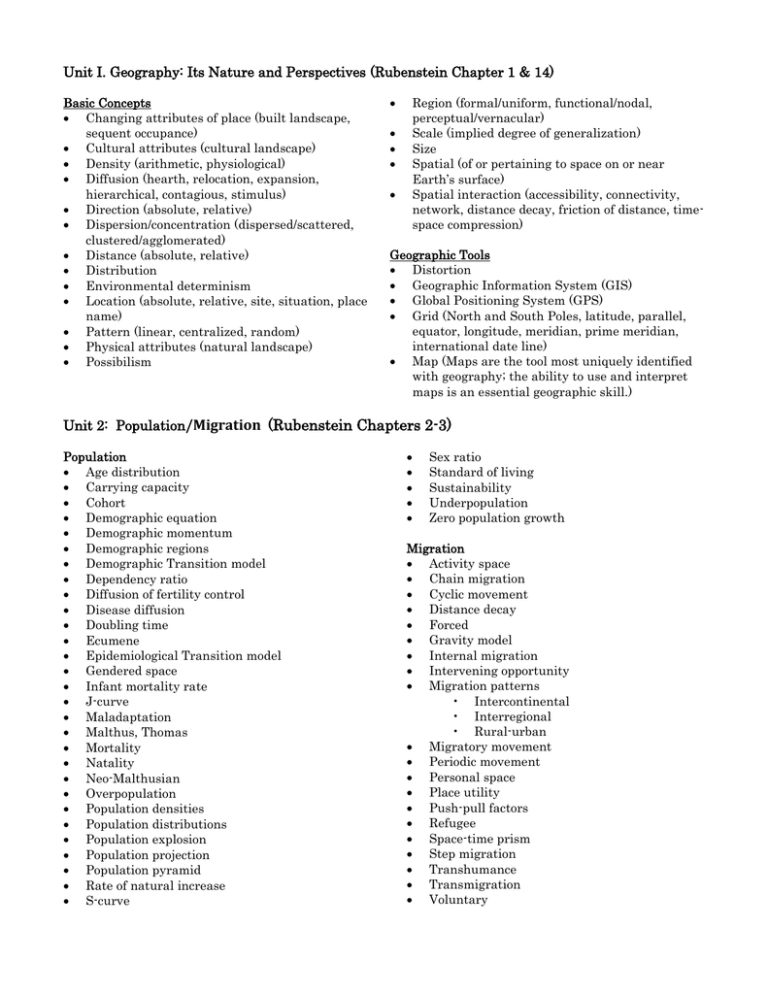
Unit I. Geography: Its Nature and Perspectives (Rubenstein Chapter 1 & 14) Basic Concepts Changing attributes of place (built landscape, sequent occupance) Cultural attributes (cultural landscape) Density (arithmetic, physiological) Diffusion (hearth, relocation, expansion, hierarchical, contagious, stimulus) Direction (absolute, relative) Dispersion/concentration (dispersed/scattered, clustered/agglomerated) Distance (absolute, relative) Distribution Environmental determinism Location (absolute, relative, site, situation, place name) Pattern (linear, centralized, random) Physical attributes (natural landscape) Possibilism Region (formal/uniform, functional/nodal, perceptual/vernacular) Scale (implied degree of generalization) Size Spatial (of or pertaining to space on or near Earth’s surface) Spatial interaction (accessibility, connectivity, network, distance decay, friction of distance, timespace compression) Geographic Tools Distortion Geographic Information System (GIS) Global Positioning System (GPS) Grid (North and South Poles, latitude, parallel, equator, longitude, meridian, prime meridian, international date line) Map (Maps are the tool most uniquely identified with geography; the ability to use and interpret maps is an essential geographic skill.) Unit 2: Population/Migration (Rubenstein Chapters 2-3) Population Age distribution Carrying capacity Cohort Demographic equation Demographic momentum Demographic regions Demographic Transition model Dependency ratio Diffusion of fertility control Disease diffusion Doubling time Ecumene Epidemiological Transition model Gendered space Infant mortality rate J-curve Maladaptation Malthus, Thomas Mortality Natality Neo-Malthusian Overpopulation Population densities Population distributions Population explosion Population projection Population pyramid Rate of natural increase S-curve Sex ratio Standard of living Sustainability Underpopulation Zero population growth Migration Activity space Chain migration Cyclic movement Distance decay Forced Gravity model Internal migration Intervening opportunity Migration patterns • Intercontinental • Interregional • Rural-urban Migratory movement Periodic movement Personal space Place utility Push-pull factors Refugee Space-time prism Step migration Transhumance Transmigration Voluntary Unit 3: Cultural Patterns and Processes(Rubenstein Chapters 4-7) Concepts of Culture Acculturation Assimilation Cultural adaptation Cultural core/periphery pattern Cultural ecology Cultural identity Cultural landscape Cultural realm Culture Culture region • Formal—core, periphery • Functional—node • Vernacular (perceptual)—regional selfawareness Diffusion types • Expansion—hierarchical, contagious, stimulus • Relocation Innovation adoption Maladaptive diffusion Sequent occupance Folk and Popular Culture Adaptive strategies Anglo-American landscape characteristics Architectural form Built environment Folk culture Folk food Folk house Folk songs Folklore Material culture Nonmaterial culture Popular culture Survey systems Traditional architecture Language Creole Dialect Indo-European languages Isogloss Language Language family Language group Language subfamily Lingua franca Linguistic diversity Monolingual/multilingual Official language Pidgin Toponymy Trade language Map scale Map types (thematic, statistical, cartogram, dot, choropleth, isoline) Mental map Model (a simplified abstraction of reality, structured to clarify causal relationships): Geographers use models (e.g., Demographic Transition, Epidemiological Transition, Gravity, Von Thünen, Weber, Stages of Growth [Rostow], Concentric Circle [Burgess], Sector [Hoyt], Multiple Nuclei, Central Place [Christaller], and so on) to explain patterns, make informed decisions, & predict behaviors. Projection Remote sensing Time zones Religion Animism Buddhism, Hinduism, Islam, Judaism Cargo cult pilgrimage Christianity Confucianism Ethnic religion Exclave/enclave Fundamentalism Geomancy (fengshui) Hadj Interfaith boundaries Jainism Landscapes of the dead Monotheism/polytheism Mormonism Muslim pilgrimage Muslim population Proselytic religion Reincarnation Religion (groups, places) Religious architectural styles Religious conflict Religious culture hearth Religious toponym Sacred space Secularism Shamanism Sharia law Shintoism Sikhism Sunni/Shia Taoism Theocracy Universalizing Zoroastrianism Ethnicity Acculturation Adaptive strategy Assimilation Barrio Chain migration Cultural adaptation; Cultural shatterbelt Ethnic cleansing Ethnic conflict Ethnic enclave Ethnic group Ethnic homeland;Ethnic neighborhood Ethnic landscape Ethnicity Ethnocentrism Ghetto Plural society Race Segregation Social distance Gender Dowry death Enfranchisement Gender Gender gap Infanticide Longevity gap Maternal mortality rate Unit 4: Political Organization Of Space(Rubenstein Chapter 8) Annexation Antarctica Apartheid Balkanization Border landscape Boundary, disputes (definitional, locational, operational, allocational) Boundary, origin (antecedent, subsequent, superimposed, relic) Boundary, process (definition, delimitation, demarcation) Boundary, type (natural/physical, ethnographic/cultural, geometric) Buffer state Capital Centrifugal VsCentripetal City-state Colonialism Confederation Conference of Berlin (1884) Core/periphery Decolonization Devolution Domino theory EEZ (Exclusive Economic Zone) Electoral regions Enclave/exclave Ethnic conflict European Union Federal Forward capital Frontier Geopolitics Gerrymander Global commons Heartland/rimland Immigrant states International organization Iron Curtain Irredentism Israel/Palestine Landlocked Law of the Sea Lebanon Mackinder, Halford J. Manifest destiny Median-line principle Microstate;Ministate Nation;Nation-state National iconography Nunavut Raison d’être Reapportionment Regionalism Religious conflict Reunification Satellite state Self-determination Shatterbelt Sovereignty State Stateless ethnic groups Stateless nation Suffrage Supranationalism Territorial disputes Territorial morphology (compact, fragmented, elongated, prorupt, perforated) Territoriality Theocracy Treaty ports UNCLOS (United Nations Convention on the Law of the Sea) Unitary USSR collapse Women’s enfranchisement Unit 5: Agriculture and Rural Land Use(Rubenstein Chapter 10) Adaptive strategies Agrarian Agribusiness Agricultural industrialization Agricultural landscape Agricultural location model Agricultural origins Agriculture Animal domestication Aquaculture Biorevolution Biotechnology Collective farm Commercial agriculture (intensive, extensive) Core/periphery Crop rotation Cultivation regions Dairying Debt-for-nature swap Diffusion Double cropping Economic activity (primary, secondary, tertiary, quaternary, quinary) Environmental modification (pesticides, soil erosion, desertification) Extensive subsistence agriculture (shifting cultivation [slash-and- burn, milpa, swidden], nomadic herding/pastoralism) Extractive industry Farm crisis Farming Feedlot First agricultural revolution Fishing Food chain Forestry Globalized agriculture Green revolution Growing season Hunting and gathering Intensive subsistence agriculture Intertillage Livestock ranching Market gardening Mediterranean agriculture Mineral fuels Mining Planned economy Plant domestication Plantation agriculture Renewable/nonrenewable Rural settlement (dispersed, nucleated, building material, village form) Sauer, Carl O. Second agricultural revolution Specialization Staple grains Suitcase farm Survey patterns (long lots, metes and bounds, township-and-range) Sustainable yield Third agricultural revolution (mechanization, chemical farming, food manufacturing) “Tragedy of the commons” Transhumance Truck farm Von Thünen, Johann Heinrich Unit 6: Industrialization & Development (Rubenstein Chapters 9, 11) Development Agricultural labor force Calorie consumption Core-periphery model Cultural convergence Dependency theory Development Energy consumption Foreign direct investment Gender Gross domestic product (GDP) Gross national product (GNP) Human Development Index Levels of development Measures of development Neocolonialism Physical Quality of Life Index Purchasing power parity Rostow, W “Stages of Growth”model Technology gap; Technology transfer Third World World Systems Theory Industrialization Acid rain Agglomeration Agglomeration economies Air pollution Aluminum industry (factors of production, location) Assembly line production/Fordism Bid rent theory Break-of-bulk point Canadian industrial heartland Carrier efficiency Comparative advantage Cumulative causation Deglomeration Deindustrialization Economic sectors Economies of scale Ecotourism Energy resources Entrepôt Export processing zone Fixed costs Footloose industry Four Tigers Greenhouse effect Growth poles Heartland/rimland Industrial location theory Industrial regions (place, fuel source, characteristics) Industrial Revolution Industry (receding, growing) Infrastructure International division of labor Labor-intensive Least-cost location Major manufacturing regions Manufacturing exports Manufacturing/warehouse location (industrial parks, agglomeration, shared services, zoning, transportation, taxes, environmental considerations) Maquiladora Market orientation Multiplier effect NAFTA Outsourcing Ozone depletion Plant location (supplies, “just in time” delivery) Postindustrial Refrigeration Resource crisis Resource orientation Special economic zones (China) Specialized economic zones Substitution principle Threshold/range Time-space compression Topocide Trade (complementarity) Transnational corporation Ubiquitous Variable costs Weber, Alfred Weight-gaining Weight-losing World cities Unit 7: Cities and Urban Land Use(Rubenstein Chapters 12, 13) Agglomeration Barriadas Bid-rent theory Blockbusting CBD (central business district) Census tract Centrality Centralization Central-place theory Christaller, Walter City Cityscapes Colonial city Commercialization Commuter zone Concentric zone model Counterurbanization Decentralization Deindustrialization Early cities Economic base (basic/nonbasic) Edge city Emerging cities Employment structure Entrepôt Ethnic neighborhood Favela Female-headed household Festival landscape Gateway city Gender Gentrification Ghetto Globalization Great cities High-tech corridors Hinterland Hydraulic civilization Indigenous city In-filling Informal sector Infrastructure Inner city Invasion and succession Lateral commuting Medieval cities Megacities Megalopolis/conurbation Metropolitan area Multiple nuclei model Multiplier effect Neighborhood Office park Peak land value intersection Planned communities Postindustrial city Postmodern urban landscape Primate city Racial steering Rank-size rule Redlining Restrictive covenants Sector model Segregation Settlement form (nucleated, dispersed, elongated) Shopping mall Site/situation Slum Social structure Specialization Squatter settlement Street pattern (grid, dendritic; access, control) Suburb Suburbanization Symbolic landscape Tenement Threshold/range Town Underclass Underemployment Urban growth rate Urban function Urban hearth area Urban heat island Urban hierarchy Urban hydrology Urban morphology Urbanization Urbanized population World city Zone in transition Zoning
